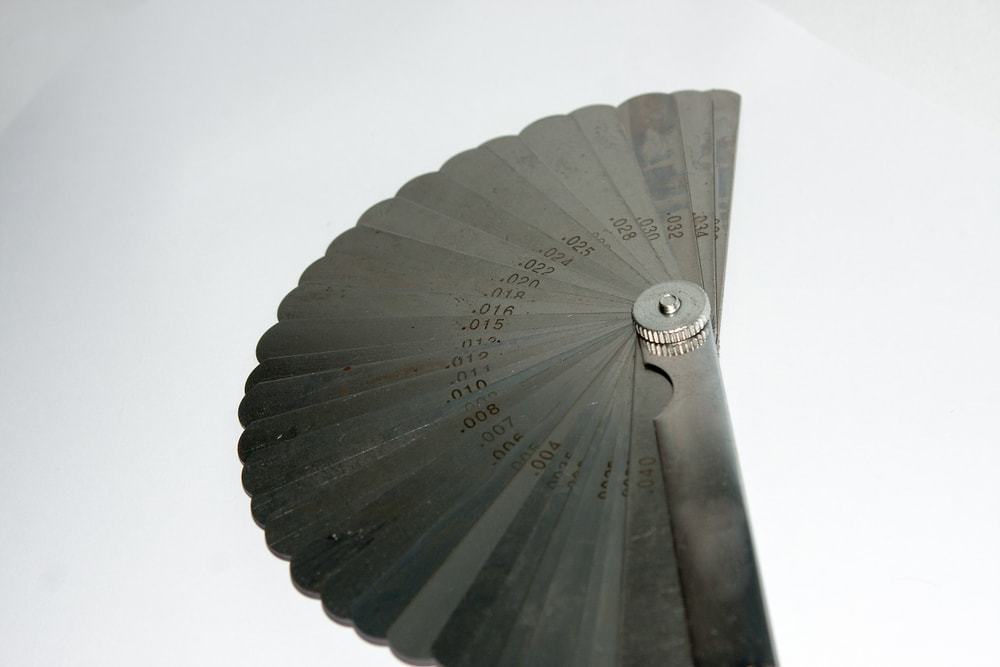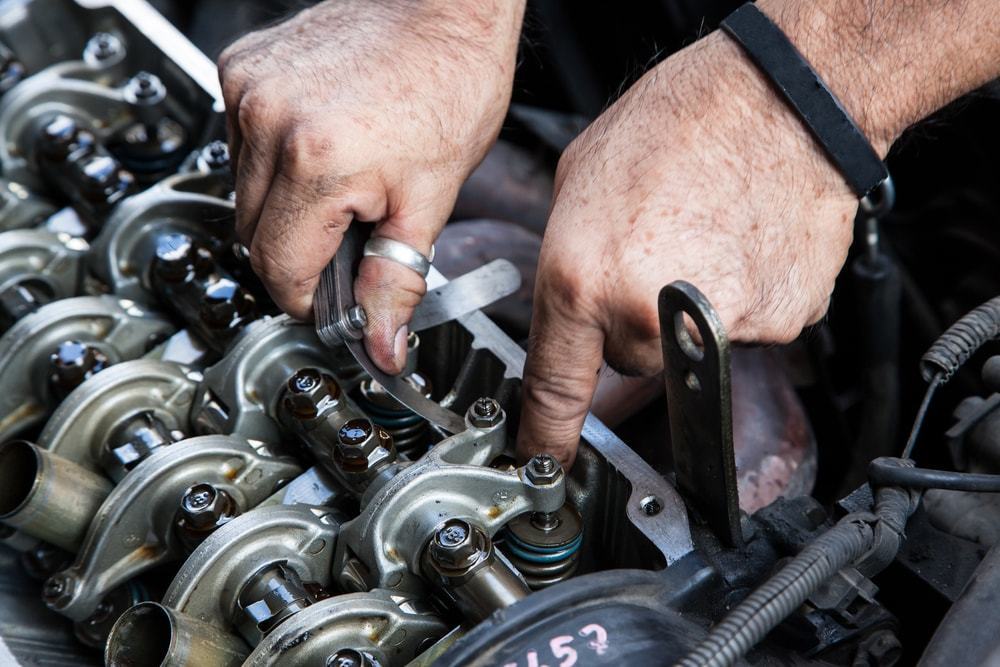Feeler Gauges Are Used for Measuring the

Prototype credit: Mr.Matoom/Shutterstock.com
Mechanical assemblies such as machines are built up from a series of mating parts. The fit of those parts is often designed to be inside a specified tolerance that assures reliable operation for the machine – for example, the fit of a piston into the cylinder of an engine. If there is too tight a fit or clearance between the piston and cylinder, the engine may endure from excessive wear and friction, shortening the life of the unit and resulting in maintenance costs and reanimation. If the gap or clearance is too wide, combustion gases may escape during pinch, reducing the engine performance. To make certain that gaps and clearances are inside specified limits, engineers, mechanics, and motorcar operators rely on the use of measuring devices such equally a feeler gauge. This commodity covers what feeler gauges are, the various types that exist, the gauge sizes, and provides some examples of typical uses for these instruments.
To larn more about the other varieties of gauges, see our related guide covering the types of gauges.
What is a Feeler Gauge?
Feeler gauges, sometimes called thickness gauges or feeler gages, are mechanical measurement instruments that are used to provide a precise reading of the gap that exists betwixt two parallel surfaces, such as the clearance between two machine parts or elements. Feeler gauges are typically sold equally what is termed a set up, with each fix consisting of a series of dimensionally accurate pieces of shim stock that are joined using a mutual shaft and nut or riveted connection. The individual pieces, which are called blades, leaves, or plates, have very precisely calibrated thicknesses and can fold or fan out as needed when a measurement is to exist taken, and can be recessed back on top of ane another to fit into the approximate handle, which serves to protect the individual blades from damage when the tool is not in use. The blades are typically produced from a high carbon steel textile. The use of loftier carbon steel is designed to ensure that the blade fabric will not compress during the measurement process, thus assuring that the gap measurements are accurate. Some models have a locking nut that can exist tightened to maintain the blade position during employ.
Each blade is annotated with its thickness designation. Different feeler gauge sets are sold with varying numbers of blades in them, which so corresponds to the overall gap range for which the gauge can be utilized.
Types of Feeler Gauges
The most common type of feeler gauge, chosen a directly leaf or straight blade gauge, consists of straight blades of uniform width constructed of high carbon steel sold in a set to cover specific dimensional values. All the same, there are variations on this standard that serve specific purposes.
Inside the blade variety of gauge, some variations include changes to the blade length (long bract and short blade feeler gauges) equally well as bent blade (also called offset) gauge sets. The aptitude blade judge set tin provide for easier use in infinite-constrained applications and for use in areas with restricted movement and access to the gap being measured. At that place is also a tapered blade type of gauge set, wherein the width of the blade becomes progressively narrower towards the bract tip, which once more, can prove valuable when in that location are space limitations involved in the work area.
Go/no-go feeler gauges use blades that have a precision footstep between two specific thicknesses, rather than having blades that have a compatible thickness across their unabridged length. Go/no-go feeler gauges are designed to simplify the interpretation of the clearance or gap value by reducing the need to rely on the user's "feel" of the guess, instead bracketing the clearance or gap value with a greater than/less than tolerance window.
Another type of feeler gauge replaces the employ of a shim stock type blade with calibrated metallic wires whose ends are bent to a right-angle. This type of gauge is termed a wire feeler judge or a spark plug gap feeler gauge, owing to its principal employ for setting the gap on spark plugs for combustion engines.
While many feeler gauge sets are available as standard items for purchase, at that place are also suppliers who will create customized feeler gauges to encounter specific needs or applications. These customization options may involve providing gauges that characteristic alternative blade materials, packaging, blade sizes, blade shapes, and tapers, as well as specialized markings.
Specifications for Feeler Gauges
Besides the overall types of feeler gauges just mentioned, buyers can look to see feeler gauge products that have some variations between them. Hither are a few of the specifications and features that should exist given consideration when looking to source or buy a feeler approximate set.
- The number of blades or leaves – Different feeler gauge sets volition feature different numbers of blades. On the low side, 10 or less, with thirteen, fifteen, 25, 26, 31 being more common blade counts, all the way up to over 100.
- Bract cloth – Equally mentioned carbon steel blades are unremarkably used, but other materials such as brass, stainless steel, and even plastic blades are available. Brass has the advantage that it will not precipitate a spark while in apply, valuable for applications where explosive atmospheres might be. Contumely is besides is non-corrosive and non-magnetic, desirable properties in uses such as electronics. Stainless steel can resist high temperatures, and plastic is non-corrosive, not-sparking, non-marring, and not-magnetic. Some of the estimate sets volition offer blades of more i cloth in the same set, such as steel and brass together.
- Blade length – Standard blade lengths are typically around 3-v inches, only long blades might be 12 inches and shorter blades around ¾ - 1 inch.
- English language vs. metric sizes – Feeler gauge sets are available in both decimal inch sizes and decimal millimeter sizes.
- Packaging – While many feeler approximate sets are available in a fan-fold fashion package where the blades fold into the handle when not in utilize, at that place are culling packaging arrangements. Some feeler estimate sets have the blades individually stored in a slotted pouch rather than connected physically together. The materials are also available in long multi human foot length coils of specific width and thickness, or equally individual blades not part of a set.
Feeler Gauge Sizes
The specific feeler gauge sizes included in a set depend on the number of blades in the ready as well every bit whether the feeler guess set is an English language or metric size set. A representative set of feeler estimate sizes for a decimal inch set is shown below in Tabular array i, and a decimal millimeter size set is shown in Table 2. These are based on a 25-bract count set – other blade combinations and sizes are bachelor.
In actual use, it is oftentimes possible to stack together more than i blade to obtain a guess for a size not included in the ready. For case, the 0.0015" and the 0.0020" sizes tin be combined to provide a gauge reference for 0.0035", which is non in the fix of blades shown below in table ane.
Table one – Typical feeler gauge bract size chart for a 25-bract decimal inch gauge gear up
| Blade Sizes (in Inches) |
| 0.0015" |
| 0.0020" |
| 0.0030" |
| 0.0040" |
| 0.0050" |
| 0.0060" |
| 0.0070" |
| 0.0080" |
| 0.0090" |
| 0.0100" |
| 0.0110" |
| 0.0120" |
| 0.0130" |
| 0.0140" |
| 0.0150" |
| 0.0160" |
| 0.0170" |
| 0.0180" |
| 0.0190" |
| 0.0200" |
| 0.0210" |
| 0.0250" |
| 0.0270" |
| 0.0300" |
| 0.0400" |
Table ii – Typical feeler gauge blade size nautical chart for a 25-blade decimal millimeter gauge set
| Blade Sizes (in mm) |
| 0.04 mm |
| 0.05 mm |
| 0.06 mm |
| 0.07 mm |
| 0.08 mm |
| 0.09 mm |
| 0.ten mm |
| 0.15 mm |
| 0.20 mm |
| 0.25 mm |
| 0.30 mm |
| 0.35 mm |
| 0.forty mm |
| 0.45 mm |
| 0.fifty mm |
| 0.55 mm |
| 0.threescore mm |
| 0.65 mm |
| 0.70 mm |
| 0.75 mm |
| 0.lxxx mm |
| 0.85 mm |
| 0.90 mm |
| 0.95 mm |
| one.00 mm |
Uses and Applications of Feeler Gauges
Feeler gauges find awarding wherever in that location is a need to accurately establish the size of the clearance or gap between two mating machine elements or surfaces and where other measuring devices, such as calipers or a steel dominion, are non able to be employed. They are normally used beyond a wide range of industries such equally aerospace, automotive, pharmaceutical, oil & gas, and general industrial machining. In automotive applications, feeler gauges can be used to gear up the valve clearance between the rocker arms and the valve stalk and to adjust the spark plug gap. In oil refinery applications, wall slot size in reactor vessels tin can be checked with a feeler gauge. Manufacturers of tapes and films may use feeler gauges to set uniform gaps on extruder dies and rollers across the full length of the dice set.

Image credit: Panaiphoto/Shutterstock.com
Summary
This article presented an overview of feeler gauges including what they are, the types, sizes, and uses. For information on other topics, consult our additional guides or visit the Thomas Supplier Discovery Platform where you can locate suppliers of feeler gauges, ultrasonic thickness gauges, digital force per unit area gauges, bore guess, depth gauges, profile gauges, ring gauges, plug & ring gauges, thread gauges, and gap measurement gauges, as well every bit potential sources of supply for over seventy,000 different production and service categories.
Sources:
- https://www.fastenal.com/
- https://precisionbrand.com/faq/feeler-gage-questions/
- https://www.easterngage.com/
- https://www.threadcheck.com/feeler-gauge-gage/
Other Gauges Articles
- Mechanical Gauges: An In-Depth Look at the Different Types of Gauges
- Magnetic Liquid Level Gages
- All About Thickness Gauges - Definition, Sizes and Uses
- All About Digital Pressure level Gauges - Definition, Sizes and Uses
- All About Bore Gauges - Definition, Sizes and Uses
- All About Depth Gauges - Definition, Sizes, and Uses
- All Nearly Profile Gauges - Definition, Sizes and Uses
- All Nearly Band Gauges - Definition, Sizes and Uses
- All About Snap Gauges - Definition, Sizes and Uses
- All Well-nigh Plug Gauges - Definition, Sizes and Uses
- All About Force Gauges - Definition, Sizes and Uses
- All Nigh Tiptop Gauges - Definition, Sizes, and Uses
- All Well-nigh Level Gauges - Definition, Sizes, and Uses
More from Instruments & Controls
Feeler Gauges Are Used for Measuring the
Posted by: 9news2onlineac.blogspot.com
comment 0 comments
more_vert